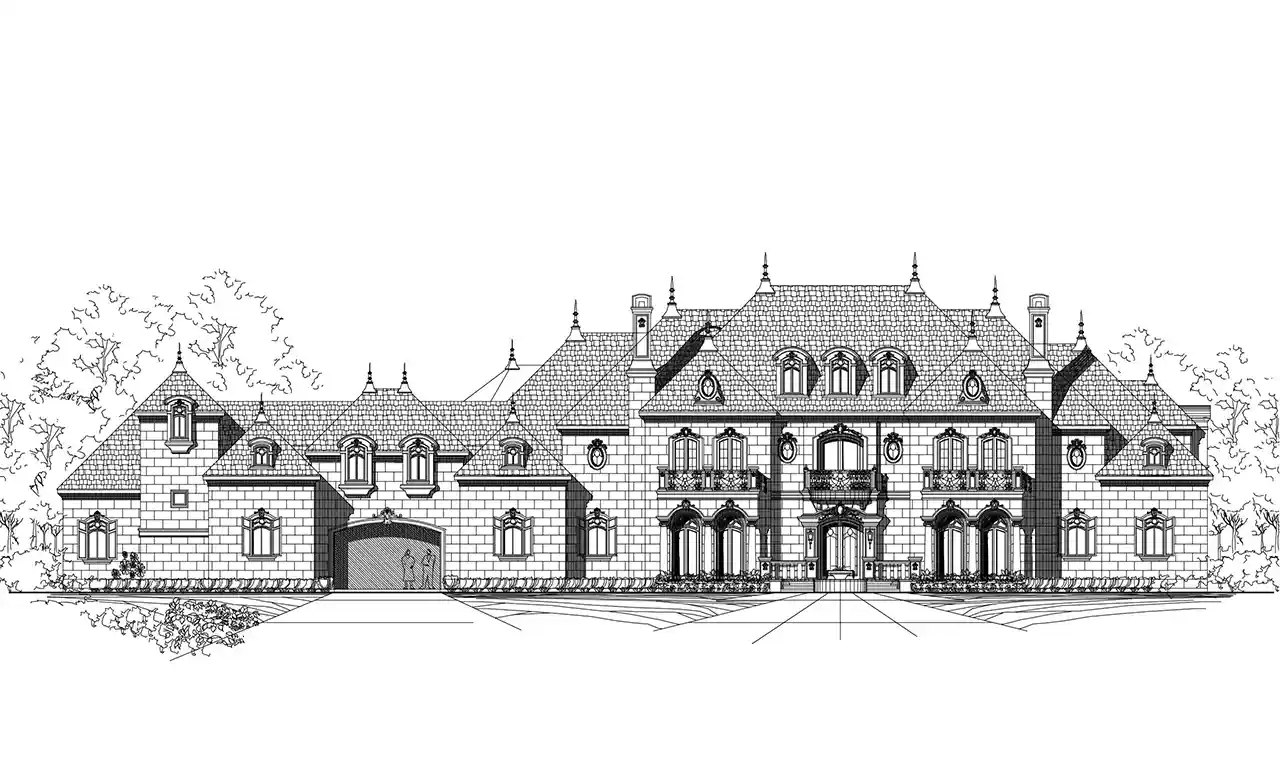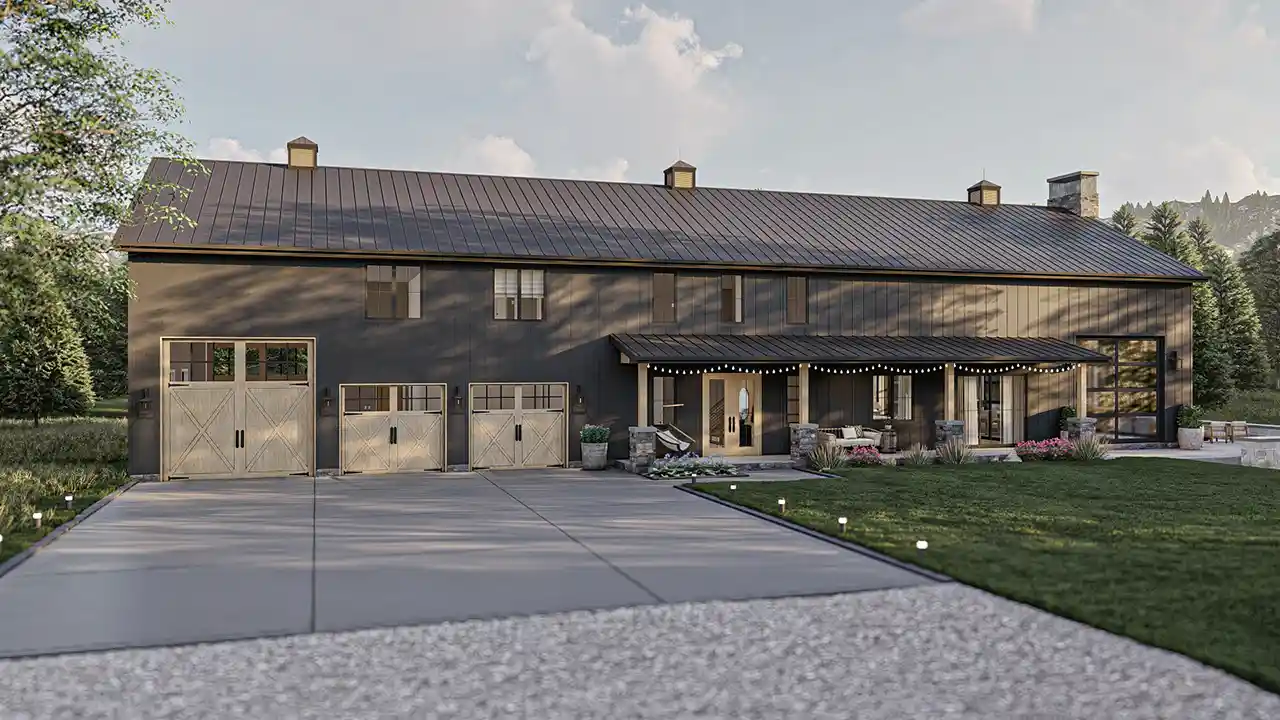Main Floor Laundry House Plans
Did you know that doing laundry is America’s favorite cleaning task? With cleaning counters and vacuuming coming in at a close second and third, having access to laundry for homeowners is more critical than ever before! But this then raises the question: What is the best floor to put a laundry room on?
Depending on the size of your home, you can choose from the basement, main floor, or the second floor. Each one has its own set of drawbacks, but ultimately, keeping your laundry on the main floor offers tons of benefits. For example, a main floor laundry room is more centrally-located, is cheaper to install, and is generally quieter.
Check out some of Monster House Plans’ extensive list of house plans with a main floor laundry room.
Read More- 2 Stories
- 5 Beds
- 5 - 1/2 Bath
- 4 Garages
- 4874 Sq.ft
- 2 Stories
- 4 Beds
- 2 - 1/2 Bath
- 2 Garages
- 2499 Sq.ft
- 3 Stories
- 3 Beds
- 2 Bath
- 2002 Sq.ft
- 2 Stories
- 6 Beds
- 6 - 1/2 Bath
- 4 Garages
- 9360 Sq.ft
- 2 Stories
- 4 Beds
- 4 - 1/2 Bath
- 4 Garages
- 5250 Sq.ft
- 2 Stories
- 9 Beds
- 8 - 1/2 Bath
- 9 Garages
- 14727 Sq.ft
- 2 Stories
- 6 Beds
- 4 - 1/2 Bath
- 4 Garages
- 4954 Sq.ft
- 2 Stories
- 6 Beds
- 5 - 1/2 Bath
- 4 Garages
- 7138 Sq.ft
- 2 Stories
- 5 Beds
- 5 - 1/2 Bath
- 3 Garages
- 4412 Sq.ft
- 2 Stories
- 5 Beds
- 4 - 1/2 Bath
- 5 Garages
- 4987 Sq.ft
- 2 Stories
- 4 Beds
- 4 - 1/2 Bath
- 3 Garages
- 2886 Sq.ft
- 2 Stories
- 7 Beds
- 7 - 1/2 Bath
- 6 Garages
- 15079 Sq.ft
- 2 Stories
- 5 Beds
- 5 - 1/2 Bath
- 3 Garages
- 4964 Sq.ft
- 2 Stories
- 5 Beds
- 3 - 1/2 Bath
- 3 Garages
- 4450 Sq.ft
- 2 Stories
- 8 Beds
- 7 - 1/2 Bath
- 4 Garages
- 11877 Sq.ft
- 2 Stories
- 6 Beds
- 4 - 1/2 Bath
- 4 Garages
- 3551 Sq.ft
- 2 Stories
- 5 Beds
- 3 Bath
- 3 Garages
- 2743 Sq.ft
- 2 Stories
- 4 Beds
- 4 - 1/2 Bath
- 3 Garages
- 4226 Sq.ft
Is It Better to Have a Modern Laundry Room Upstairs or Downstairs?
When choosing where to put a laundry room, there are a few options to choose from: The basement, the main floor, or the second floor.
These days, you can install a laundry room anywhere throughout your whole house. However, there are some locations that are the perfect solution for a laundry room and others that might need to be reconsidered, based on your personal preferences. Accessibility and mobility are two major issues that homeowners may face when putting a laundry room in particular locations.
Many older homes have laundry areas in the basement because it has close access to water lines and other utilities. Some newer homes and ranches will have laundry on the main floor, either tucked away in a closet or close to a bathroom or kitchen. Larger, two-story homes are more likely to have second-floor laundry in between the master bedroom and other rooms.
Besides this, some individuals choose other orientations for laundry rooms:
- Placing a laundry room in the garage, complete with laundry supplies, extra storage, a drying rack, and washing machines
- Opting for two laundry rooms (one in the basement and one upstairs)
- Putting a laundry room in the master bathroom (this is a great idea but requires more space)
- Converting a mud room into a partial laundry room (installing open shelving to keep muddy boots away is a must if you choose this orientation!)
- Using part of your walk-in closet space for a laundry room
The point is that you can rely on clean laundry from virtually anywhere in your home. But you need to ask yourself if the location is easily accessible. Of course, there are pros and cons to each spot, so let's take a look at which of these options gives you the most for your move.
Option #1: Basement-Level Laundry Rooms
Basements are the most common area to place a laundry room when constructing a home. Older homes that upgrade to a laundry space will almost always be installed in the basement.
This is because basements are traditionally used as utility spaces anyway, and their concrete floors provide a stable surface for heavy machines. You can easily install a laundry sink, folding table, and drying racks without worrying about water or detergent spills.
Many homeowners prefer installing a laundry room in the basement because it’s easy to access the plumbing and electrical lines. There’s also less damage if the washing machine accidentally floods, which means less money for potential repairs.
However, basements can be difficult to access every time a spin cycle is done — unless you have a walkout basement. Having your washer and dryer in the basement makes it harder to bring clean clothes up and down for every load.
Pro-tip: Some homeowners navigate around the tricky chore of transporting dirty laundry with the use of a laundry chute. That way, it's easy to transfer your next load to the laundry room location without additional effort.
Additionally, keeping your own laundry room in a basement means you may not be able to hear when wet clothes are done or the noise of your dryer units going off. That's because basements dampen sounds, so you'll need to go downstairs every time you want to check the washer and dryer.
And, while it may help you save space upstairs, it's also more expensive to install and upgrade a basement laundry room because you have to route up to your dryer ventilation.
Option #2: Second-Floor (or Upstairs) Laundry Rooms
Having an upstairs laundry room is less common, but it's definitely an option that's on the rise. Upstairs laundry rooms rate highly on many homeowners’ list of wants because they offer easy access between all the rooms you'd typically dry clothes in: the master suite, the guest bathroom, the kids' bedrooms, and more.

This is especially helpful in large families, where keeping track of everybody’s dirty clothes and laundry baskets can become a challenge in daily life.
However, washers and dryers make a lot of noise, which means they’re not ideal for light sleepers or children. The heat from the dryer can also increase the upstairs temperature, which is exhausting during the summertime. Plus, there’s more significant potential for flood damage if the washing machine suddenly malfunctions. Simple occurrences like a burst hose repair could cost you thousands because of carpeted or hardwood floors.
Option #3: Main Floor Laundry Room
First-floor laundry rooms are rather standard in many homes. Homebuyers can find most laundry rooms placed off of kitchens, bathrooms, mud rooms, or garages. Staying near the water and electric lines makes installation easy and inexpensive, which is a significant benefit.
Additionally, keeping your laundry room on the first floor makes it easy to access. Since Americans spend most of their time in their kitchens, it becomes easier to check on laundry and fold clothes when it's in this central location.

Keeping your laundry room on the main floor also helps if you're in a household with young children. Parents and guardians can easily multi-task and keep one eye on their loads and the other on the kids.
Finally, keeping a washer and dryer on the first floor also offers the opportunity for multifunctional spaces. Homeowners can choose to combine their laundry rooms with bathrooms, offices, utility closets, and bathrooms. At the end of the day, opting for a multipurpose laundry room can save you a ton of money.
Imagine what you could do with extra square footage in your home that you've been otherwise dedicating to keeping a washer and dryer.
How Much Does It Cost to Move Laundry Upstairs?
If you're interested in moving your laundry room upstairs, then costs and renovations are factors that you'll need to consider.
Although the total cost depends on the room size, materials, and actual labor, you may end up paying as much as $15,000 to move a laundry room to another location in the house. This price is a general maximum, but it includes the extension of copper pipes, longer drain lines, and other fixtures like faucets and outlets.
In addition to these base costs, you might also want to consider adding counter space, storage, and fixing the flooring so that it can accommodate a drain.
Do You Need a Floor Drain in a Laundry Room?
No code says you have to have a drain in your laundry room by law, but even if you’re looking to save a few dollars by skipping out on installing one, think again. It’s a good idea to opt for the drain in the end.
Laundry room drains are worth the investment because they can help control flooding and excessive home damage if your washer breaks or a pipe bursts. A washer produces around 20 gallons of water during a regular cycle, so it’s always better to be safe with the proper backup.
Drains for a laundry room are typically about four inches wide and are located at the lowest part of the room, usually built intentionally during the construction phase of a new house. So if you’re looking to add a drain to an existing room, you may have to do some reflooring to get the right angle for the drain.
Find House Plans with a Main Floor Laundry Room
When selecting a floor plan for your dream house, it’s always a good idea to go with one that has a first-floor laundry room.
By having a first-floor laundry room, you can stay central to the heart of your home, reduce noise throughout the upstairs, and even pay less upon installation. In addition, nearly all floor plans with a modern laundry room offer a laundry room on the first floor with a drain.
Find the perfect house plan with first-floor laundry using Monster House Plans!




















